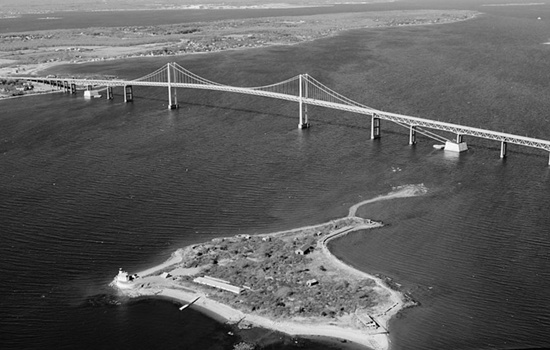Through the years, Rose Island has been used by the military due to its strategic location at the entrance to Newport Harbor. During the Revolutionary War, the island was used by both British and colonial troops at different times to defend Newport. From 1798 to 1800, a military outpost named Fort Hamilton was under construction on the island, but it was never finished. In 1889, part of the island served as a rifle range, and during World War I and II it was used for storage by the U.S. Navy’s torpedo manufacturing plant in nearby Newport. Keepers stationed at Rose Island could definitely not expect peace and quiet all the time.
The wood-framed lighthouse that stands on the island today was built in 1869 using $7,500 allocated by Congress the previous year. Activated on January 20, 1870, the Rose Island Lighthouse stands atop Fort Hamilton’s South Battery on the southwestern point of the island and replaced a private light maintained by the Bristol Steam Boat Company. The thirty-five-foot tower is attached to the western end of the keeper’s dwelling, which is two stories tall and topped with a mansard roof. The optic in the lantern room was originally a sixth-order Fresnel lens that displayed a fixed red light to guide mariners traveling along the East Passage of Narragansett Bay and those entering Newport Harbor. A brick oil house was added to the station in 1912 along with a brick fog signal building that was placed on a rock just west of and below the lighthouse.
|
On April 4 of the same year, yet another storm took the tower’s chimney down, and the roof leaked so badly that it was almost “as wet inside as out.” In November, a storm flooded the lighthouse, ruining the entire winter supply of vegetables stored there. The following month was no better, according to the lighthouse log: “Stormiest December on record, much damage to property and according to report, much loss of life at sea.”
In 1894, Captain Elijah Davis, who was nicknamed the Fog Eater for his skill at navigating in zero visibility, met his match when he ran his steamer Plymouth aground on the south shore of Rose Island. The 700 passengers on board were offloaded with no injuries, but the ship remained stranded on the island for several weeks.
Lighthouse keepers were not well paid, and they sometimes had to be creative to feed their families. At Rose Island, the keepers grew crops and kept farm animals, which sometimes wandered from the lighthouse grounds into the military compound, much to the officers’ annoyance. Two keepers at Rose Island, Charles Curtis (1887-1918) and Jesse Orton (1921-1936) both kept cows at the light station to supply milk. Curtis kept his cow in a long building behind the lighthouse that was also used for storing explosives.
Paul Stedman, one of Jesse Orton’s grandsons, tells the story of how his grandfather went ashore, bought a cow, and then brought it to the island aboard the Jamestown ferry. The ferry captain tried to maneuver his vessel close enough to the island to let down a gangplank to walk the cow ashore but was unable to find a suitable spot in the shallows. The ferry crew was thus forced to lower the cow into the water and have the bovine paddle her way to shore. With everyone on the ferry shouting their encouragement, the cow barely made it to the island, where she collapsed to the ground. Twenty-four hours passed before she had the strength to stand up and graze.
The Rose Island Lighthouse narrowly avoided destruction on August 7, 1958 when two tankers collided in heavy fog near Fort Adams and burst into flames. One of the ships, the Graham, floated into Newport Harbor with the tide, ablaze and with her engines dead, and passed within 200 yards of the Rose Island Light. The walls of the lighthouse became so hot that the keepers were forced to flee the station. Finally, the tide and wind turned and took the ship away from the lighthouse. Eighteen men from the two ships were killed in the incident.
When the Newport Bridge was opened in 1969, both the Gould Island Lighthouse north of the bridge and the Rose Island Lighthouse became obsolete. Rose Island was deactivated in 1971. In 1976, the lighthouse and grounds were given to the University of Rhode Island to use for marine research, but the school was unable to maintain the property, and the decrepit, badly vandalized lighthouse was returned to the federal government. When the lighthouse was declared surplus property in 1984, the city of Newport took it over.
A local group, the Rose Island Lighthouse Foundation, was formed, and with the help of public and private funding, the ambitious organization completely restored the lighthouse. Much of the credit for the group's success is due to its first director, Charlotte Johnson, who devoted many years to the project. The exterior of the lighthouse was completely refurbished in 1990, and the interior received new wiring, plumbing, and plaster walls, as well as an energy-efficient in-floor radiant heating system. A septic field, a water cistern, and a landing dock were also installed. Altogether the restoration cost $250,000. In 1992, the lighthouse was opened to the public. The following year, the lighthouse once again became an active aid to navigation, showing a white light flashing every six seconds. In 1999, the Rose Island Lighthouse Foundation acquired the rest of the island, which is off-limits, save its beaches during a portion of the year, due to safety concerns.





No comments:
Post a Comment